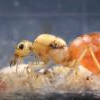










Edited by nurbs, March 27 2025 - 11:17 PM.












Edited by nurbs, March 27 2025 - 11:17 PM.
Instagram:
nurbsants
YouTube
California Ants for Sale
Unidentified Myrmecocystus
https://www.formicul...ls-near-desert/
Undescribed "Modoc"
https://www.formicul...mp-ca-5-4-2017/
Camponotus or Colobopsis yogi:
https://www.formicul...a-ca-1-28-2018/
Camponotus us-ca02
https://www.formicul...onotus-us-ca02/
Unidentified Formica
https://www.formicul...l-ca-6-27-2020/
Pencil Case and Test Tube Formicariums
https://www.formicul...m-and-outworld/
Bloodworm Soup
https://www.formicul...bloodworm-soup/
Good luck
I love Camponotus!
Old Shop: https://www.formicul...-stallbay-area/
Current Shop: https://www.formicul...17962-ant-dump/
Huh fascinating. How many did you get. I want one. Hehe.
The worker's head shape looks strikingly similar to M. ewarti, however the pilosity doesn't appear to match, not to mention that M. ewarti are not nearly as large as your specimens seem to be. It's a possibility, but it doesn't seem to match perfectly. Good luck with this one, it's very curious.
I like leafcutter ants. Watch The Ultimate Guide to Fungus Growing Ants:
https://youtu.be/VBH...4GkxujxMETFPt8U
This video took like over 100 hours of work, you should for sure watch it.
Can you pin them up and get profile closer face images?
It'll be cool to figure out what these are, hopefully the couple queens TheAntGuy and I found do good. They are very pretty besides them having mites everywhere on them(we picked them off while in the field), luckily they didn't suck them dry like the Myrmecocystus Testaceus we also found. ![]()
Tapinoma?
Perhaps T. Sessile?
Tapinoma?
Perhaps T. Sessile?
Very different genus. These are definitely Myrmecocystus.
Tapinoma?
Perhaps T. Sessile?
Very different genus. These are definitely Myrmecocystus.
I mean no disrespect. I just so happen to disagree with you.
Most definitely Myrmecocystus.
Keep in mind that the ants do not read the literature. I have found M. testaceus as far out into the desert as Rosamond. That said these appear to be quite hairy. Based on the images provided, in my dads key which admittedly is a bit complex these key out to either M. mexicanus or M. testaceus. A closer idea of where these were found would help with the Id process.
Edited by gcsnelling, April 19 2021 - 3:19 PM.
Tapinoma?
Perhaps T. Sessile?
Very different genus. These are definitely Myrmecocystus.
I mean no disrespect. I just so happen to disagree with you.
It is definitely Myrmecocystus
1X Pogonomyrmex occidentalis 40-50 Workers
1X Solenopsis molesta 10 Workers (mono)
Ants I Want: Crematogaster sp, Camponotus Sp., Ponera Pennsylvanica, Mymercocystus sp.
My Youtube channel: https://www.youtube....kUjx-dPFMyVqOLw
Join Our Fledgling Discord Server https://discord.com/...089056687423489
Tapinoma?
Perhaps T. Sessile?
Very different genus. These are definitely Myrmecocystus.
I mean no disrespect. I just so happen to disagree with you.
It is definitely Myrmecocystus
I agree, most definitely Myrmecocystus.
Tapinoma?
Perhaps T. Sessile?
How'd you come to this conclusion? Just curious.
My Main Journal | My Neivamyrmex Journal | My Ant Adoption | My YouTube
Join the TennesseeAnts Discord Server! https://discord.gg/JbKwPgs
No its Myrmecocystus, where did you get the idea that it is tapinoma lolVery different genus. These are definitely Myrmecocystus.Tapinoma?
Perhaps T. Sessile?
I mean no disrespect. I just so happen to disagree with you.
Ant Shop: (restocking soon) https://www.formicul...op/#entry195574 ![]()
What if it is a hybrid. Just gonna throw that in there. Unlikley but not impossible.
You could try sending an email/tweet to Marek Borowiec -- he recently published a highly relevant paper, though this paper seems to take a purely molecular approach to phylogeny. At a minimum I'm sure he could connect you to an expert who may have an idea from the physical features.
My main takeaway from quickly skimming the paper is that there is a lot of un-described diversity in Myrmecocystus, so it seems highly possible it is indeed an un-described species
https://www.scienced...055790320303080
Absolutely not a hybrid.
What makes you say this?
Absolutely not a hybrid.
What makes you say this?
There probably aren't any features too different from those already present in Myrmecocystus that aren't hybrids, but it is different enough to be an undescribed species within the genus. However, I'm not the scientist here so I am curious as to what he will say.
Edited by Kaelwizard, April 21 2021 - 10:02 AM.
I suppose I should have not implied a hybrid between Tapinoma and Myrmecocystus. It is not impossible I suppose for it to be a hybrid between two Myrmecocystus species though. However ant hybrids are quite rare and none are known for this genus. Keep in mind I did not say it was an undescribed species, but rather that it is not impossible for it to be one. However the genus is fairly well known in California and as a result I am leaning towards this being a known species which is poorly known. Again a more precise location would help.
Edited by gcsnelling, April 22 2021 - 2:17 AM.
0 members, 1 guests, 0 anonymous users